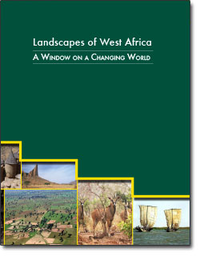Landscapes of West Africa: A window on a changing world
Links
- More Information:
- Documents:
- Download citation as: RIS | Dublin Core
Abstract
Our global ecosystem is and has always been complex, dynamic, and in constant flux. Science tells us how natural forces of enormous power have shaped and reshaped Earth’s surface, atmosphere, climate, and biota again and again since the planet’s beginnings about 4.5 billion years ago. For most of the planet’s history those environmental changes were the result of the interaction of natural processes such as geology and climate and were described on the geological time scale in epochs spanning millions of years.
When humankind appeared on Earth around 200,000 years ago the influence of human activity on the environment must have been small and localized. The influence of scattered small groups of people on the global ecosystem would have been overwhelmed by the forces of natural systems (Steffen and others, 207). Human population would not grow to 50 million (about 0.7 percent of the Earth’s current population) for another 197,000 years. Population growth accelerated over the centuries that followed until the planet was adding more than that 50 million people every year. Our planet is now home to roughly 7.3 billion people and we are adding 1 million more people roughly every 4.8 days (US Census Bureau, 2011). Before 1950, no one on Earth had lived through a doubling of the human population, but now some people have experienced a tripling in their lifetime (Cohen, 2003).
Study Area
| Publication type | Book |
|---|---|
| Publication Subtype | Monograph |
| Title | Landscapes of West Africa: A window on a changing world |
| DOI | 10.5066/F7N014QZ |
| Year Published | 2016 |
| Language | English |
| Publisher | United States Geological Survey |
| Publisher location | Garretson, SD |
| Contributing office(s) | Earth Resources Observation and Science (EROS) Center |
| Description | x, 219 p. |
| Other Geospatial | West Africa |


